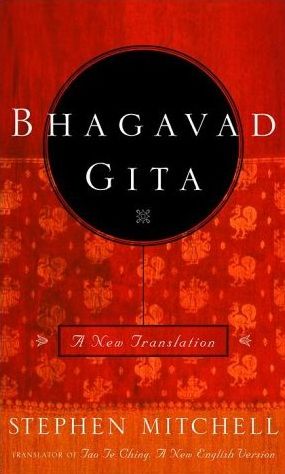The response to my announcement of our new Gita Talk online discussion series has been overwhelming. Thank you for your interest and support.
Let’s begin by reading the introduction (thru p. 35) of Stephen Mitchell’s Bhagavad Gita–A New Translation. Then on August 29 I’ll put out a blog with some discussion provoking questions.
That doesn’t mean we can’t start talking now, though. Let’s tell each other what our experience with the Gita is going in.
1) Have you read the Bhagavad Gita before or is this your first time?
2) Either way, what is your impression of the Gita going in to this discussion?
3) What are you hoping to get out of this discussion series?
I encourage you to dive into the discussion right away with both feet. The more people who participate, the better it is for everyone. And I deeply appreciate anyone who is willing to help us respond to all the comments.
This time you can look ahead if you like, because we will be following, with some additions, the original sixteen session Gita Talk. You can also see the Gita sliced and diced by major theme in the sequel sixteen part series Gita in a Nutshell: Big Ideas & Best Quotations, which just ended recently.
Gita Talk is like an online book club. We will read about one chapter per week and discuss it right here on Elephant. Join our Gita Talk Facebook page for weekly notices of each new discussion blog and to get to know your fellow Gita geeks. Each blog also gives you the short reading assignment for the next week.
I am very pleased to have Elephant writer Jennifer Cusano as my partner in running this new Gita Talk. Jennifer will moderate the discussions and will get the word out about Gita Talk in the social media.
If you ever have any questions or issues you’d like to discuss with me one-on-one, please write to me at [email protected]. I’m anxious to be personally helpful to you in any way I can.
A Little Background Material
The Bhagavad Gita is one of the “big three” ancient Yoga texts, along with the Upanishads and the Yoga Sutra. The Yoga Sutra gets 95% of the attention, but it is quite incomplete without the other two. The three together are nothing short of astounding.
My own feelings about the Bhagavad Gita are well expressed in my review last year of Mitchell’s version:
Falling Head-Over-Heels In Love with the Universe
For those of you who have always wanted to absorb the spectacular wisdom of the Bhagavad Gita, but have found it difficult, I highly recommend Bhagavad Gita: A New Translation by Stephen Mitchell. This is my fourth version and sixth reading of the Bhagavad Gita. I have gotten a lot from all four versions, but Mitchell’s is clearly the most accessible and enjoyable, without sacrificing any of the meaning.
The Bhagavad Gita is quite literally about falling in love with the indescribable wonder of the universe, that is to say, God. These two are synonymous in the Gita. (Believe it or not, the text itself says that you can approach God as either an unfathomable cosmic life-force or as an intimate personal diety. Either leads you to the same boundless love and joy.)
The Bhagavad Gita and the Yoga Sutra are two of the most important ancient texts of Yoga. They could not be more different. The Yoga Sutra is mostly secular in nature, and mentions God only briefly and perfunctorily. The Bhagavad Gita, in contrast, is literally “The Song of the Beloved Lord”, and most of the text is the voice of the awesome life-force of the universe itself.
The Yoga Sutra is a cookbook for achieving inner peace. The Bhagavad Gita is a very practical document as well, but won’t settle for anything less than ecstatic union with the universe. Put them together and you have the astounding philosophy of Yoga in two relatively short texts.
Try Mitchell’s version of the Bhagavad Gita. You’ll be glad you did.
So, again, the assignment for next week, August 29, is to read the Introduction (th p. 35), and share with us any thoughts you have before we get started on the text itself.
All questions and comments at any level are welcome at all times.












Read 50 comments and reply